🎒 Coding for kids – a comprehensive momDad guide
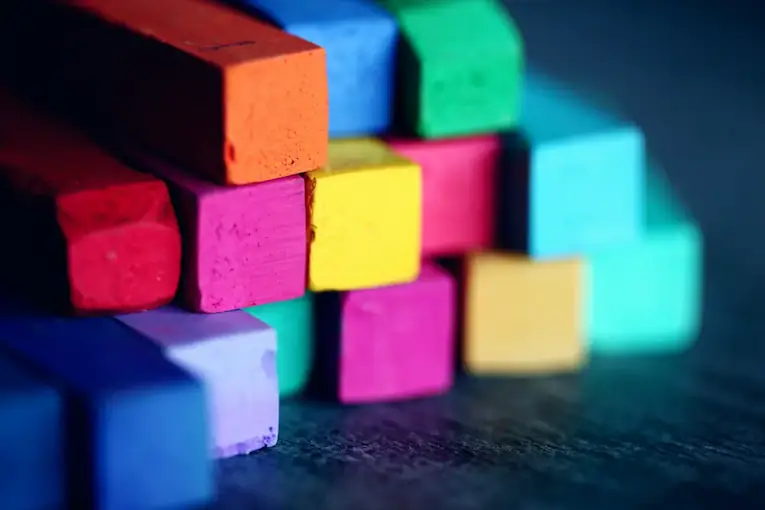
Coding for kids has become an exciting topic among parents and teachers; You might have heard coding is the new literacy and the language of the future!
But whichever it is, our world heavily depends on it, from mobile apps to rocket ships.
If you’re a parent, you’re probably wondering how your child can benefit from learning to code.
This guide covers the following topics:
- What is coding? Is it any good for kids?
- Coding for kids according to statistics
- The benefits for kids and teens to learn to code
- The best age for kids to start coding
- How to introduce coding to kids?
- How to teach coding to kids?
What is coding? Is it any good for kids?
Coding, a.k.a programming, is the act of making computer programs.
A computer program is a sequence of instructions for a computer to perform a specific task.
A task can be as simple as drawing a circle on the screen or sophisticated, like sending astronauts to space and docking them onto the International Space Station!
A programming language is like a human language but is used to communicate instructions to a computer via a text-based or visual interface.
Each programmer may know one or more programming languages, and depending on the language, they combine keywords and symbols to program instructions – line by line!
Hundreds of domain-specific and multi-purpose programming languages have been invented, each best at doing specific tasks.
Some programming languages are great for creating mobile apps and websites; Some work better with artificial intelligence (AI) and machine learning (ML) use cases, and some are more common in the robotics industry.
But is coding good for children?
The short answer is yes.
Coding can be a launchpad for students to pursue careers in STEM and technology-related fields. That’s what I love about programming. It’s a great way to get into almost any industry as a programmer; Engineering, medical, and aerospace are just a few examples.
Kids don’t have to use a text-based programming language to learn to code, though!
They can learn the basics of coding with simplified programming languages or even activities that don’t require screens.
As they learn more, they can gradually switch to text-based programming languages.
Coding for kids according to statistics
The number of parents and teachers involving their young students in coding programs has risen substantially over the past decade; The numbers continue to grow as organizations like Code.org lead the way in this space.
On Code.org alone, over 1 million teachers have taken steps to bring computer science to their schools – to teach 36 million students computer science and programming.
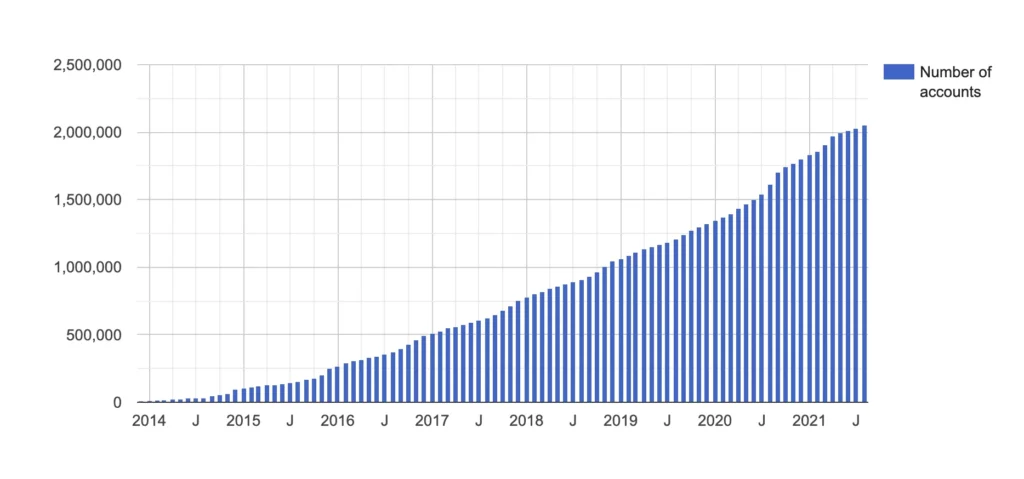
Based 2021 State of Computer Science Education report, 51% of public high schools in the United States offer foundational computer science.
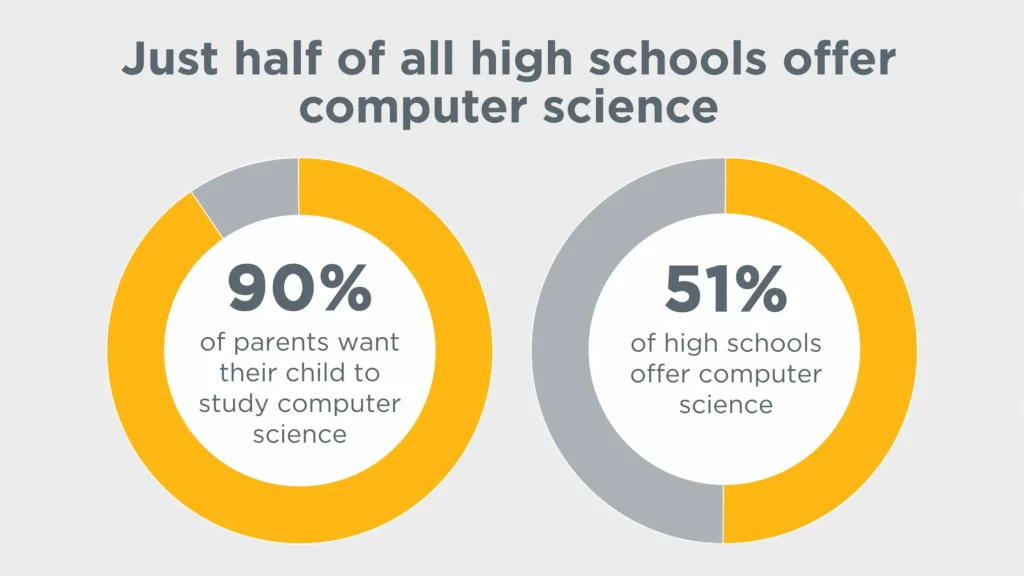
According to a recent Gallup and Google study, nine in ten parents say offering computer science programs at the school is a good use of resources.
According to the same data, 91% of parents wanted their kids to learn more about computer science in the future.
Bureau of Labor Statistics estimates the average growth rate for computer and information technology occupations to be 13% from 2020 to 2030. These occupations are projected to add about 667,600 new jobs.
According to BLS, the median annual wage for computer and information technology jobs was $97,430 as of May 2021; This amount is more than the median annual wage for all occupations of $45,760.
To get an idea, you can take a look at our salary guide for web and software developers.
And we’re not in the future yet!
The benefits for kids and teens to learn to code
Children are inspired by curiosity; They tend to explore their surroundings and look for ways around challenges.
On the other hand, tackling obstacles is what they do to have fun!
And learning to code at a young age is a playful yet effective way to foster their soft skills such as thinking and problem-solving.
And guess what, coding can be a great bonding activity for you and your child too – a great opportunity to enhance their teamwork and communication skills.
In a study by researchers at Tufts University (Medford, MA), parents and children were engaged to code together using the ScratchJr app (a simple programming language for kids aged 7 to 9). According to the findings, parents were engaged as observers and coaches, and kids were reported as planners.
There are actually more benefits to learning to code than you might think.
Here are 7 benefits of learning to code at a young age:
- Thinking skills
- Problem-solving
- Creativity
- Persistence
- Confidence
- High demand jobs
Let’s take a closer look.
💡 Thinking skills: The human mind is a wonderful thing! We can switch to various thinking modes to create a different representation of the information inside our minds and apply knowledge accordingly – just like how optimists and pessimists react differently to the same problem.
Based on a study from data collected from 5-6-year-old students in a New Zealand primary school, teaching basic coding to young students may be an effective way to exercise their general and higher-order thinking skills.
Coding teaches children various thinking skills, including but not limited to:
- Critical thinking: carefully evaluating their ideas with an open mind. Thinking critically helps children to agree (or disagree) with others based on facts and logic rather than relying on emotions.
- Creative thinking: to think outside the box; It gives them the courage to try unconventional solutions to new problems.
- Analytical thinking: to break down a problem and evaluate each part from various dimensions before tackling it as a whole.
🤔 Problem-solving: Problem-solving is using logic and experience to find the root cause of a problem and fix it.
Kids are natural problem solvers! They’re always looking for opportunities to solve puzzles while having fun. Programming isn’t different than those puzzles; It’s all about solving problems with technology or making existing solutions more efficient.
Based on a 2013 study on problem-solving by kindergarten children in a coding environment, children will have opportunities to develop “mathematical concepts, problem-solving and social skills”.
🎨 Creativity: Programmers often need to take unconventional approaches to solve coding problems.
Engineering is the art of creating great things despite the existing obstacles and limitations.
And it’s where a bit of creativity comes in handy!
Sometimes you have to think beyond what you already know to work around brand-new problems; Coding exposes kids to fun and entertaining challenges and encourages them to think outside the box.
🏋️♀️ Persistence: Persistence means not giving up when you fail.
Programmers usually joke if a program works on the first try, there’s defintely something wrong!
That’s how their minds interpret failure; They see failures as a prerequisite to delivering robust and reliable computer programs.
I like Elon Musk’s quote on failure:
“Failure is an option here. If things are not failing you are not innovating.”
Angela Duckworth is a professor of psychology at the University of Pennsylvania. She has a theory on one’s perseverance, tenacity, and passion for long-term goals.
Her theory starts with the assumption that success in education and in life is not simply a result of intellectual talent; It’s our perseverance, dedication, and commitment toward our meaningful goals.
✅ Confidence: We gain confidence when we accomplish goals. Children will find coding fascinating as they create things with their own hands; The amazing feeling of creating something unique gets addictive pretty soon.
Coding projects teach children that there’s always a solution to problems no matter how difficult they look!
These skills can be applied to different aspects of life.
The best age for kids to start coding
Anyone can learn to code; From 5 year-olds kids to 50 year-olds folks. However, there are many advantages in learning it at a young age.
According to Stackoverflow’s 2021 survey, around 68% of software developers learned to code before they turned 17!
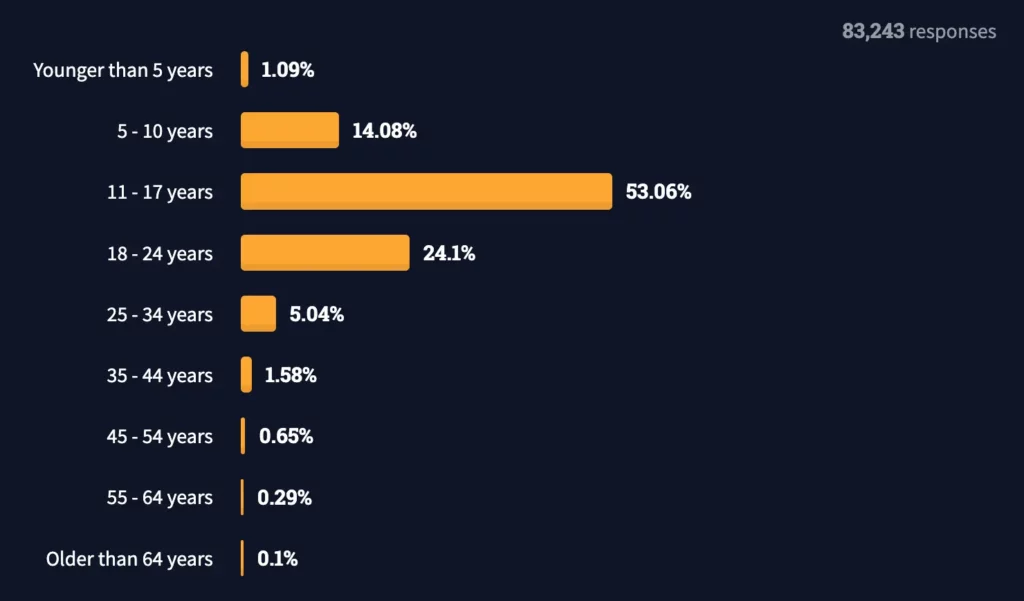
In the UK, teaching computer science and programming is compulsory in all maintained schools – from ages 5 to 16!
Estonian schools teach programming to children as young as seven. No wonder why many multi-billion dollar companies such as Skype, Wise, Bolt, and Pipedrive have been founded by talented Estonian engineers.
How to introduce coding to kids?
Before anything, we need to help children understand what they are doing and why they are doing it.
Kids are naturally creative beings who want to explore the world around them and control it in a variety of ways. They’ll find coding lessons engaging if they learn how to code simple video games that involve walking, running, and jumping!
Luckily, there are many toys, apps, and simplified programming languages designed to make young learners interested in coding and computer science.
How to teach coding to kids?
If you’ve read this far, you’re probably considering coding for your child, and you’re wondering how you can help your child learn to code.
I’ve tried several online platforms so far with my son. One of these platforms has in common is they teach coding concepts in the form of games, animations, and stories via simplified programming languages.
Let’s see what they are.
1. Scratch and ScratchJr
Format: Online, app Age group: 5/8+ years Cost: Free
Block-based coding provides an easy-to-use interface for young programmers.
In block-based coding, the programmer drags and drops blocks onto a workspace to create programs, interactive stories, and games – Just like a jigsaw puzzle!
Each block represents a language feature, like a function (move, stop, walk).
A block-based language enables children to focus on learning programming concepts and see instant results – without being distracted by syntax mistakes commonly made by beginners.
One of the most popular and intuitive block-based programming languages is Scratch, a great educational tool for programming developed at MIT.
Children aged 8 to 6 can use Scratch to program their own stories, games, and animations.
ScratchJr is a derivative of Scratch (suitable for children of ages 5 to 7) and is a collaboration between Tufts University and the Scratch Foundation.
The Official ScratchJr Book and ScratchJr Coding Cards (a deck of 75 activity cards) are great additions to the app; They cover fun and exciting projects designed to educate young children with ScratchJr.
2. Code.org
Format: Videos, games, block programming, etc Age group: +5 Cost: Free,
Code.org is a non-profit organization with one goal: “to teach every student in every school computer science.”
Over 70 million students have learned on Code.org through fun interactive courses and activities.
To test the waters, you can start with an Hour of Code, which contains plenty of game-like lessons where kids can make games and animations with themes such as Minecraft, Frozen, and Star Wars.
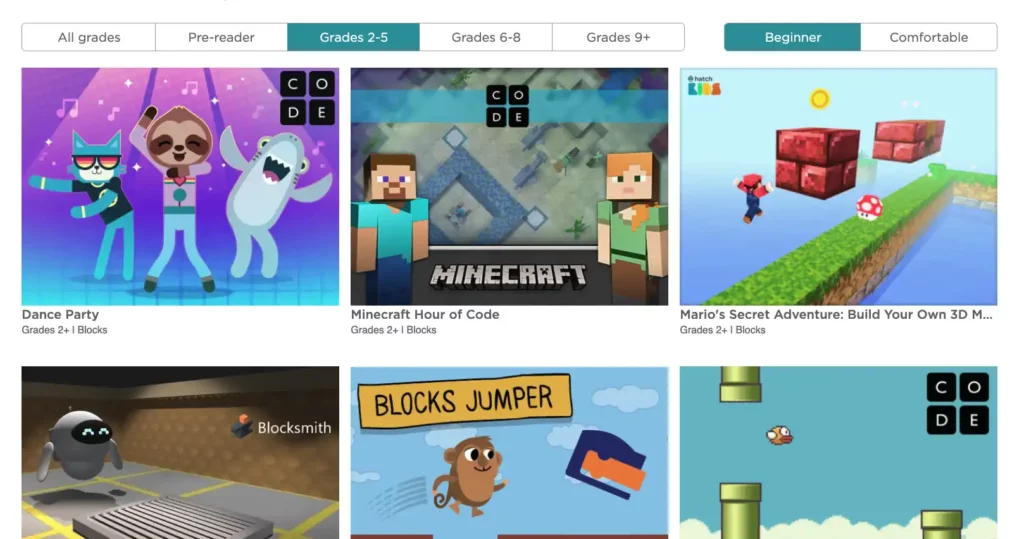
Your child can play games created by other students or make their own via Game Lab and App Lab.
And if you don’t have a computer at home, you can try out the mobile coding apps from Code.org partners:
- Box Island (suitable for all ages)
- codeSpark (ages 5-9)
- Grasshopper (for middle school and up)
Additionally, you can use unplugged coding activities, which I’ll cover shortly.
3. CodeMonkey:
Format: website & apps Age group: 4-14 years old Cost: Paid (with a 14 days trial period – but no credit card required)
Codemonkey is an award-winning platform that teaches kids programming concepts via block-based and text-based programming languages in game-like environments.
This is the platform I’ve used the most with my 8-year-old son, and we love it so far! Over 32 million kids (from 4 to 14-year-old) have taken programming courses on CodeMonkey.
In CodeMonkey lessons, the objectives are usually to help animals overcome challenges and reach their goals. Students will continue the fun as they meet new characters and learn more advanced coding concepts.
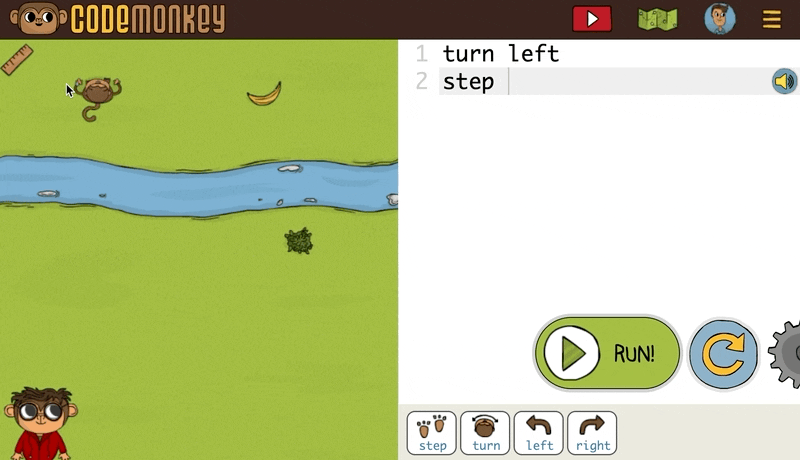
For instance, Banana Tales is a fun coding game for 6th-7th graders.
In this game, students need to help reunite twin baby monkeys who got separated after an earthquake hit.
Along the way, students will be exposed to various coding concepts as they rebuild a baby monkey’s pathway back home.
When you sign up to CodeMonkey, you’ll receive two accounts; One for yourself and one for your child.
The parent dashboard enables you to monitor your child’s progress and review the concepts they’ve learned.
During these games, children are exposed to real-world programming concepts such as:
- Conditionals
- Variables
- Loops
- String manipulation
- Data structures
- Server-side programming
- Classes
- And more.
4.CodeCombat
Format: RPG game development, text-based programming Age group: 7-16 years old, Cost: Free & paid
CodeCombat is an innovative game-based educational platform to help students (+7 years old) learn to code with simplified text-based programming and RPG (Role Playing Game) game development.
Children start with choosing and equipping a hero; The objective is to write simple programs and help their hero overcome challenges and progress to higher levels.
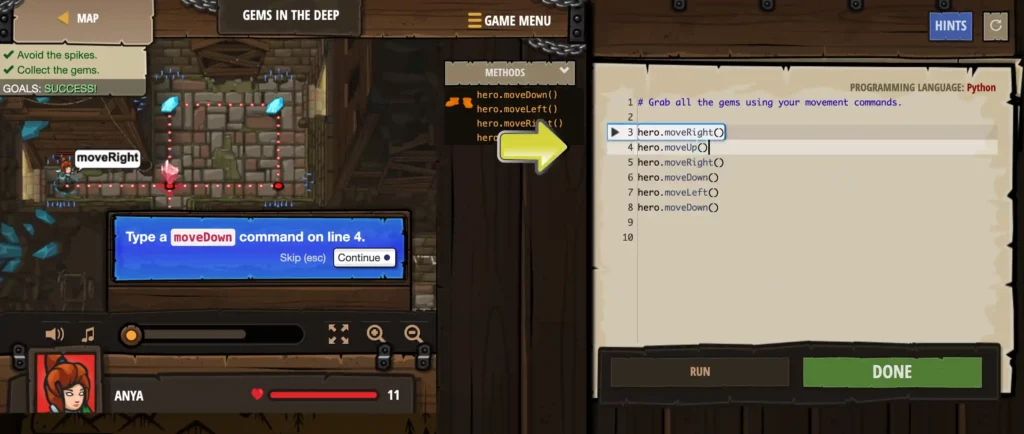
Kids will have fun helping their heroes progress while learning real-world programming languages such as Python, JavaScript, C++, and Java (C++ and Java are only available to paid accounts, though.).
The environment is quite intuitive, thanks to helpful and well-placed hints to help the kids find their way around the environment.
They also offer online coding classes (available as private or group options).
Classes are a combination of gameplay and personalized instructions.
When you apply to the online coding classes, you’ll have a 60-minute private session, where they can evaluate your child’s current skill level and also answer your questions.
After the initial trial, they match an online instructor to your child – based on their experience level, interests, etc.
5. Tynker:
Format: Block-based programming and game-like activities Age group: 7-18 years old, Cost: Free & paid
Tynker is an award-winning education platform that offers kids and teens story-based programming lessons and block-based coding in a safe and moderated environment.
Over 60 million students have used tinker to learn computer science, computing, and programming.
In addition to the self-paced and game-like courses, they provide teacher-led private online classes too.
Students can learn at their own pace with 6 progressive levels, including unlimited access to over 5,000 learning modules.
The modules are organized in:
- The introduction to coding (for children 7-12),
- Real-world coding (for ages 13-18+).
In the Introduction to coding, kids learn how to build simple apps and games, explore STEM subjects, and design Minecraft mods, to name a few.
In Real-world coding, however, teens will be exposed to real-world use cases, such as JavaScript, Python, web development (such as HTML & CSS), data science, and more.
Apart from the web-based app, you can also use their iOS mobile apps, Tynker (ages 7-12) and Tynker Junior (ages 5-7), to access the lessons.
6. Unplugged coding activities
If you’re worried about your child’s screen time, you can switch to unplugged activities from time to time.
You can find plenty of coding-related activities (typically with paper and pens) online that your children can enjoy playing away from the screens.
Unplugged activities are a great alternative to screen-based activities if your child hasn’t learned to use computers or tablets yet or they use screens all day long.
Worksheets: Using printable worksheets is a great way to engage kids with coding activities without a computer. Most worksheets only require pen and paper, and you can take them anywhere with you. Here are examples of some worksheets:
Coding toys and robots: A few years ago, I was looking for a coding robot for my 6-year-old son to teach him programming concepts.
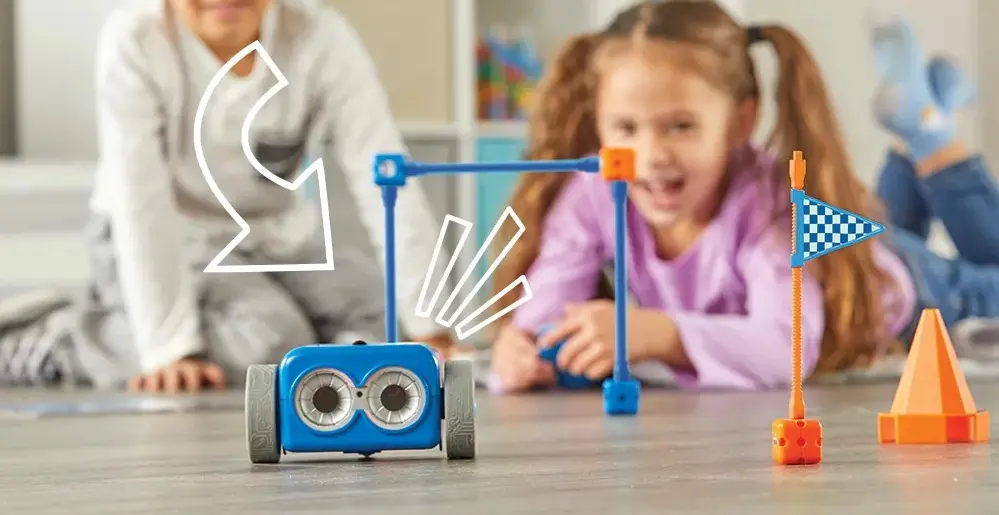
After weeks of reading and watching, I found Botley Learning Resources; Botley is a cute coding robot, which helps kids learn programming basics in a fun way.
Customer reviews weren’t the same, though. Some people were absolutely satisfied, and some weren’t happy with it.
However, I finally made up my mind and ordered the robot from Amazon; It came bundled with an activity kit consisting of arms, flags, obstacles, balls, tiles, etc.
We’ve been using it for almost 3 years, and I’m quite satisfied with my purchase. The activity kit was super helpful because I could design an infinite number of coding scenarios for him to practice.
Players use a deck of command cards (such as directions forward, left, right, etc) to program the robot’s behavior, for instance, to fetch a ball hidden behind a wall!
Then, they insert the commands into the robot’s remote programmer. And finally, they transmit the program Botley’s with the help of a big button on the remote programmer.
The robot also has a black-line following sensor as well as an obstacle detection sensor.
With the help of Botley and CodeMonkey lessons, I managed to get my son interested in programming.
Wrapping up
I hope this guide could give you an introduction to coding and help your child learn the basic programming concepts.
It could be a perfect way to make yourself spend more quality time with your children.
Thank you for reading.
Good luck.
Never miss a guide like this!
Disclaimer: This post may contain affiliate links. I might receive a commission if a purchase is made. However, it doesn’t change the cost you’ll pay.

